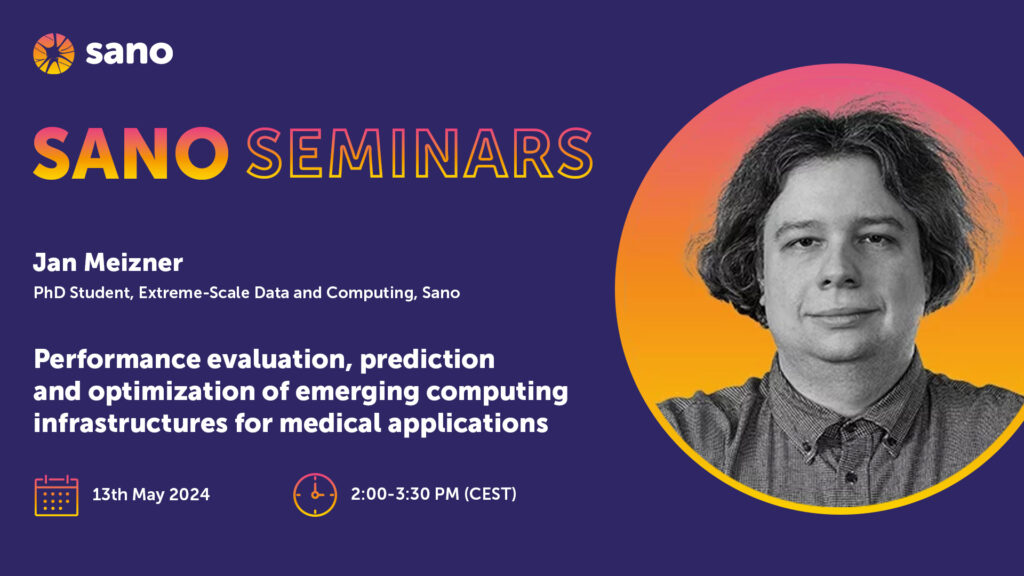133. Performance evaluation, prediction and optimization of emerging computing infrastructures for medical applications.
Jan Meizner – PhD Student, Extreme-Scale Data and Computing, Sano Centre for Computational Medicine, Krakow, PL
Abstract
To facilite better diagnosis and treatment of wide range of health-related issues various computational models were created. This includes Computational Fluid Dynamics (CFD) simulations for blood-flow related issues such as the post-thrombotic syndrome [1] or valvular heart conditions (like aortic valve stenosis and mitral valve regurgitation) [2]. At the same time numerical simulations based on the Finite Element Analysis (FEA) may be used for estimation of a risk of bone fractures. They usually require huge computational resources commonly provided only by the supercomputers located at HPC Centers possibly augmented with Cloud resources [3].
To facilite better diagnosis and treatment of wide range of health-related issues various computational models were created. This includes Computational Fluid Dynamics (CFD) simulations for blood-flow related issues such as the post-thrombotic syndrome [1] or valvular heart conditions (like aortic valve stenosis and mitral valve regurgitation) [2]. At the same time numerical simulations based on the Finite Element Analysis (FEA) may be used for estimation of a risk of bone fractures. They usually require huge computational resources commonly provided only by the supercomputers located at HPC Centers possibly augmented with Cloud resources [3].
At the same time different kind of computations may require other kind of resources, for example a genomics and transcriptomics computations consume significant amount of storage space and random-access memory.
Multitude of models and infrastructures makes it really challenging to perform computations in an efficient and economic way. It prompted the work presented in this talk to answer fundamental question – how to find best infrastructure and configuration for given computational model for most wide selection of problems.
Obviously, many monitoring systems already exist, yet some of them like Zabbix [4] are designed for the enterprise-class applications and in turn are not well suited for a hybrid HPC/Cloud infrastructure. Other solutions like the Prometheus [5], may be adapted and integrated to build an appropriate platform.
As there is no single ready-made solution for described problem a new one has been proposed based on combination of data collected from the applications itself (either by analysis of application logs or instrumentation) with the resource monitoring system based on the Prometheus platform.
The solution has been validated on two distinct use-cases – one involving the compute-intensive CFD simulation of the blood flow and the other based on the data-intensive Genomics pipeline.
[1] Otta, M., Halliday, I., Tsui, J., Lim, C., Struzik, Z.R., Narracott, A. (2022). Sensitivity Analysis of a Model of Lower Limb Haemodynamics. Computational Science – ICCS 2022. ICCS 2022. Lecture Notes in Computer Science, vol 13352. Springer, Cham.
[2] M. Bubak, K. Czechowicz, T. Gubała, D. R. Hose, M. Kasztelnik, M. Malawski, J. Meizner, P. Nowakowski, and S. Wood. 2021. The eurvalve model execution environment. Interface Focus, 11, 1, 20200006
[3] Bobak, M., Belloum, A., Cushing, R., Meizner, J., Nowakowski, P., Tran, V., Habala, O., Maassen, J., Somosköi, B., Graziani, M., Heikkurinen, M., Höb, M., Schmidt, J., Hluchý, L. 2019. Reference Exascale Architecture.
[4] Zabbix, https://www.zabbix.com/
[5] Prometheus, https://prometheus.io/
About the author
Jan Meizner graduated the Faculty of Electrical Engineering, Automatics, Computer Science and Electronics in the field of Computer Science (Distributed Systems and Computer Networks). His master thesis – Security in Virtual Laboratory System – was created in the scope of the EU Project Virolab adressing early aspects of In-Silico Medicine. He continues his reaserch by participation in over 10 EU and National projects mostly in the field of computational medicine all of which strongly focused on HPC and Cloud systems.


